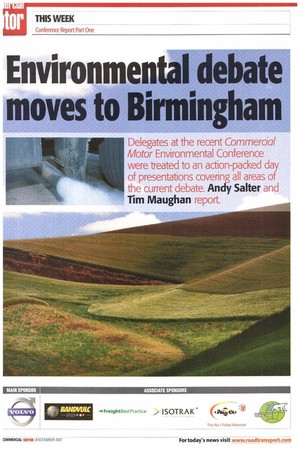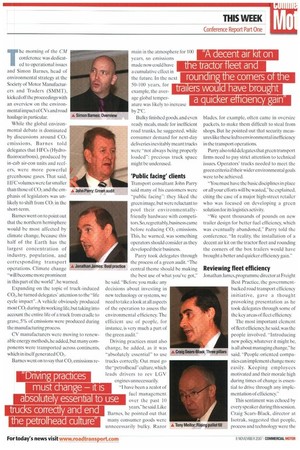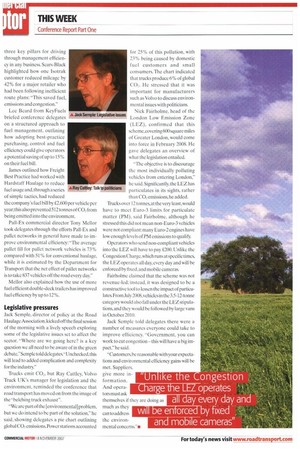Environmental debate!
Page 32

Page 33

Page 34

If you've noticed an error in this article please click here to report it so we can fix it.
moves to Birmingham
Delegates at the recent commercial Motor Environmental Conference
were treated to an action-packed day of presentations covering all areas of the current debate. Andy Salter and Tim Maughan report.
The morning of the CM conference was dedicated to operational issues and Simon Barnes, head of environmental strategy at the Society of Motor Manufacturers and Traders (SMMT), kicked off the proceeding with an overview on the environmental impact of CVs and road haulage in particular.
While the global environmental debate is dominated by discussions around CO2 emissions, Barnes told delegates that HFCs (Hydrofluorocarbons), produced by in-cab air-con units and reefers, were more powerful greenhouse gases. That said, 1 IFC volumes were far smaller than those of CO2 and the em*John Parry: Green audit phasis of legislators was unlikely to shift from CO2 in the short-term.
Barnes went on to point out that the northern hemisphere would be most affected by climate change, because this half of the Earth has the largest concentration of industry, population, and corresponding transport operations. Climate change "will become more prominent in this part of the world", he warned.
Expanding on the topic of truck-induced CO2, he turned delegates' attention to the "life cycle impact". A vehicle obviously produced most CO2 during its working life, but taking into account the entire life of a truck from cradle to grave, 5% of emissions were produced during the manufacturing process.
CV manufacturers were moving to renewable energy methods, he added, but many components were transported across continents, which in itself generated CO2.
Barnes went on to say that CO2 emissions re main in the atmosphere for 100 years, so emissions made now could have a cumulative effect in the future. In the next 50-100 years, for example, the average global temperature was likely to increase by 2'C.
Bulky finished goods, and even ready meals, made for inefficient road trunks, he suggested, while consumer demand for next-day deliveries inevitably meant trucks were "not always being properly loaded": precious truck space might be underused.
' 'Public facing' clients Transport consultant John Parry said many of his customers were -public facing": they liked the green image, but were reluctant to pool their environmentallyfriendly hardware with competitors.So,regrettably,business came before reducing CO2 emissions. This, he warned, was something operators should consider as they developed their business.
Driving practices must also change, he added, as it was -absolutely essential" to use trucks correctly. Out must go the"petrolhead" culture, which leads drivers to rev LGV engines unnecessarily.
"I have been a zealot of fuel management over the past 10 years,"hesaid.Like Barnes, he pointed out that many consumer goods were unnecessarily bulky. Razor blades, for example, often came in oversize packets, to make them difficult to steal from shops. But he pointed out that security measures like these led to environmental inefficiency in the transport operations.
Parry also told delegates that green transport firms need to pay strict attention to technical issues. Operators' trucks needed to meet the green criteria if their wider environmental goals were to he achieved.
"You must have the basic disciplines in place or all your efforts will be wasted," he explained, citing the case of a major high-street retailer who was focused on developing a green solution for its logistics activity.
"We spent thousands of pounds on new trailer design for better fuel efficiency, which was eventually abandoned," Parry told the conference. "In reality, the installation of a decent air kit on the tractor fleet and rounding the corners of the box trailers would have brought a better and quicker efficiency gain."
Reviewing fleet efficiency
Jonathan James,programme director at Freight Best Practice, the governmentbacked road transport efficiency initiative, gave a thought provoking presentation as he took delegates through some of the key areas of fleet efficiency.
The most important element of fleet efficiency, he said, was the people involved. "Introducing new policy, whatever it might be, is all about managing change," he said. "People-oriented companies can implement change more easily. Keeping employees motivated and their morale high during times of change is essential to drive through any implementation of efficiency."
This sentiment was echoed by every speaker during this session. Craig Scars-Black, director at Isotrak, suggested that people, process and technology were the three key pillars for driving through management efficiency in any business. Sears-Black highlighted how one Isotrak customer reduced mileage by 42% for a major retailer who had been following inefficient route plans: "This saved fuel, emissions and congesti Lee Beard from KeyFuels briefed conference delegates on a structured approach to fuel management. outlining how adopting best-practice purchasing, control and fuel efficiency could give operators a potential saving of up to 15% on their fuel bill.
James outlined how Freight Best Practice had worked with Hardstaff Haulage to reduce fuel usage and,through a series of simple tactics, had reduced the company's fuel bill by £2,600 per vehicle per year;this also prevented 512 tonnes of CO2 from being emitted into the environment.
Pall-Ex commercial director Tony Mellor took delegates through the efforts Pall-Ex and pallet networks in general have made to improve environmental efficiency: "The average pallet fill for pallet network vehicles is 73% compared with 51% for conventional haulage, while it is estimated by the Department for Transport that the net effect of pallet networks is to take 837 vehicles off the road every day.
Mellor also explained how the use of more fuel efficient double-deck trailers has improved fuel efficiency by up to 12%.
Legislative pressures Jack Semple, director of policy at the Road Haulage Association, kicked off the final session of the morning with a lively speech exploring some of the legislative issues set to affect the sector. "Where are we going here? is a key question we all need to be aware of in the green debate," Semple told delegates."Unchecked,this will lead to added complication and complexity for the industry."
Trucks emit CO2, but Ray Cattley, Volvo Truck UK's manager for legislation and the environment, reminded the conference that road transport has moved on from the image of the "belching truck exhaust".
"We arc part of the [environmental] problem, but we do intend to be part of the solution," he said, showing delegates a pie chart outlining global CO2 emissions, Power stations accounted for 25% of this pollution, with 23% being caused by domestic fuel customers and small consumers. The chart indicated that trucks produce 6% of global CO2. He stressed that it was important for manufacturers such as Volvo to discuss environmental issues with politicians.
Nick Fairholme, head of the London Low Emission Zone (LEZ), confirmed that this scheme,covering 600 square miles of Greater London, would come into force in February 2008. He gave delegates an overview of what the legislation entailed.
"The objective is to discourage the most individually polluting vehicles from entering London," he said. Significantly. the LEZ has particulates in its sights, rather than CO2 emissions, he added.
Trucks over I 2 tonn es, at the very least,would have to meet Euro-3 limits for particulate matter (PM), said Fairholme, although he stressed this did not mean non-Euro-3 vehicles were not compliant: many Euro-2 engines have low enough levels of PM emissions to qualify.
Operators who send non-compliant vehicles into the LEZ will have to pay £200. Unlike the Congestion Charge, which runs at specific times, the LEZ operates all day, every day and will be enforced by fixed, and mobile cameras.
Fairholme claimed that the scheme was not revenue-led; instead, it was designed to be a constructive tool to lessen the impact of particulates.From July 2008, vehicles in the 3.5-12-tonne category would also fall under the LEZ stipulations, and they would be followed by large vans in October 2010.
Jack Semple told delegates there were a number of measures everyone could take to improve efficiency. "Government, you can work to cut congestion— this will have a big impact," he said.






















































































































































































